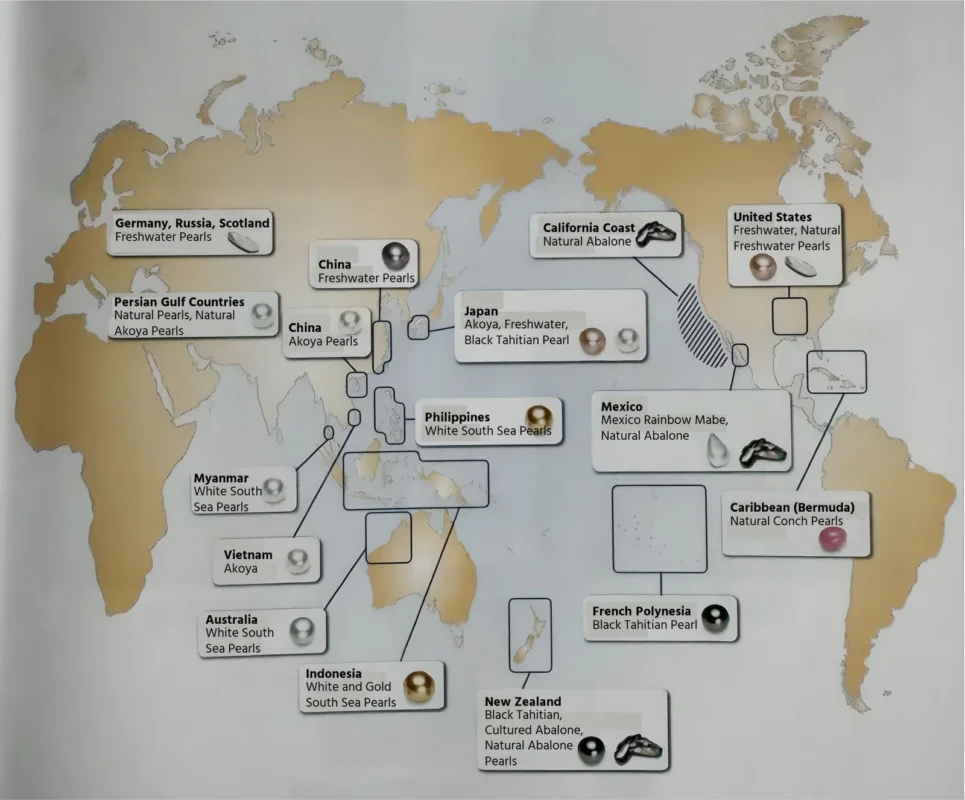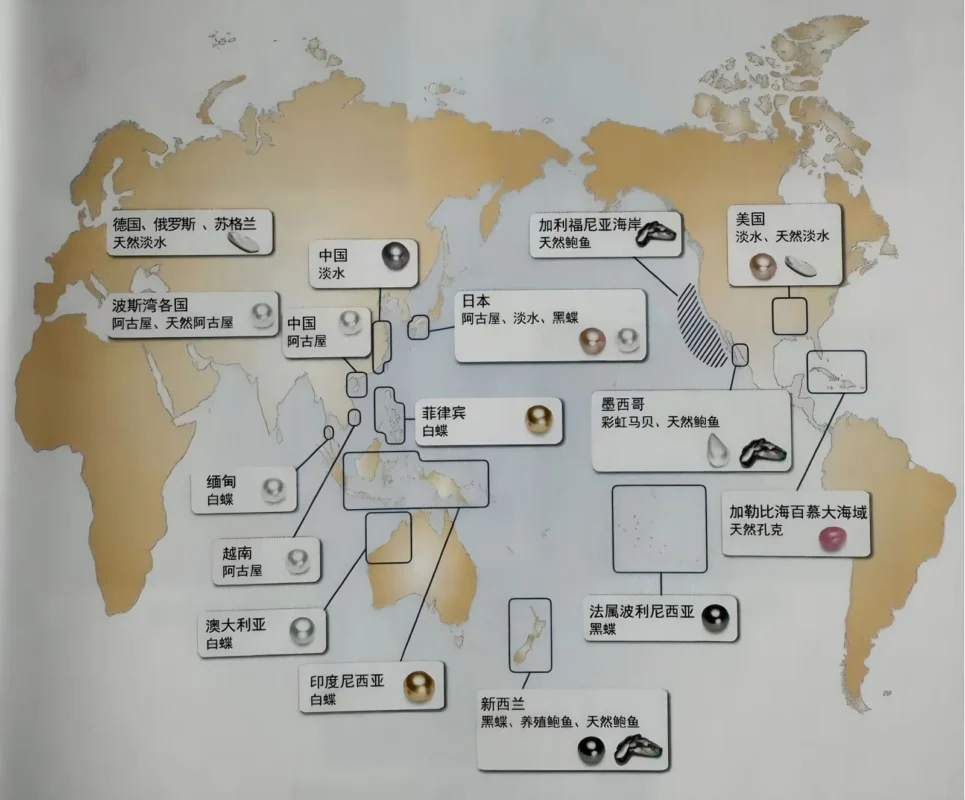Lesson3: Global Pearl-Producing Regions

● Production Map


- Note: This map is extracted from The Pearl Book.
Japan
1. Overview:
Japan is the birthplace of modern pearl cultivation technology, especially known for its high-quality seawater pearls—Akoya Pearls. Japan is a key global producer of premium Akoya pearls and also cultivates freshwater and South Sea pearls.
2. Key Regions:
Akoya pearl farming is concentrated in Mie, Ehime, Nagasaki, Oita, and Kumamoto Prefectures, accounting for over 90% of Japan’s production. Other regions with small-scale farming include Saga and Wakayama.
Ise Bay, located south of Shima Peninsula in Mie, is one of Japan’s earliest and most famous pearl farming regions, known as the “cradle of pearls.” This region played a vital role in industrializing pearl farming under Kokichi Mikimoto, solidifying Japan’s leadership in the global pearl industry. Today, Akoya pearl farming is primarily in Ehime and Kumamoto due to environmental concerns.
3. Farming Characteristics:
- Crossbreeding: To reduce high mortality rates in inbred oysters, Chinese pearl oysters are crossbred with Japanese oysters.
- Strict Regulation: The Japanese government enforces strict environmental and quality standards. Akoya pearls must have a nacre thickness of at least 0.3mm to be marketable. Most traded Akoya pearls have nacre thicknesses of 0.35-0.4mm.
- Branding: Prominent brands like Mikimoto and TASAKI have established Japan’s pearl reputation.
- Industry Standards: The Japan Pearl Science Laboratory certifies Akoya and South Sea pearls based on a comprehensive grading system.
Australia
1. Overview:
Australia is known for South Sea pearls, particularly the “Australian White” variety, valued for their high quality. These pearls are typically large, averaging 12mm or more, with a lustrous surface, strong sheen, and smooth texture.
2. Key Regions:
90% of Australia’s pearl farms are located along the northern coast, especially near Broome.
3. Farming Characteristics:
- Advanced Technology: Combining local experience with international techniques, particularly Japanese methods, ensures high-quality pearls through careful management, artificial insemination, and nucleus implantation.
- Sustainability: The industry emphasizes sustainable farming and environmental protection.
- Branding: Renowned brands include Paspaley and Autore.
China
1. Overview:
China is the world’s largest pearl producer, especially for freshwater pearls, accounting for 95% of global output.
2. Key Regions:
Freshwater pearl farms are mainly in the Yangtze River basin, including Zhejiang, Jiangsu, Jiangxi, Hubei, and Anhui. Seawater pearl farms are in Hainan, Guangxi, and Guangdong.
3. Farming Characteristics:
- High Production: China dominates global freshwater pearl production.
- Diversity: Shapes include round, oval, and baroque, meeting diverse market needs.
- Quality Improvement: Advances in technology have improved pearl quality, with varieties like Edison Pearls and Jumbo Pearls gaining popularity.
- Environmental Awareness: Sustainable practices are promoted to reduce pollution, including centralized waste management and efficient feeding methods.
Philippines
- The Philippines is another significant producer of South Sea pearls, primarily cultivating the gold-lipped oyster (Pinctada maxima) for South Sea golden pearls. The farming is mainly concentrated in the waters around Busuanga Island.
French Polynesia
- Particularly in Tahiti, this region is renowned for its production of black pearls, known as Tahitian pearls. These pearls are cultivated using the black-lipped oyster (Pinctada margaritifera). Tahitian pearls are famous for their unique dark hues and rich metallic luster.
Indonesia
- The pearl farming industry in Indonesia is primarily concentrated in the waters surrounding islands such as Bali and Lombok. The region is known for producing high-quality South Sea golden pearls and South Sea white pearls. The farming process involves artificial breeding, with a cultivation cycle ranging from 15 to 22 months. The size of the pearls is generally smaller compared to those from Australia, typically around 8-9mm.
Myanmar
- The pearl farming in Myanmar is primarily concentrated in the southernmost part of the country, specifically in the Mergui Archipelago. This region, located in the Andaman Sea, consists of hundreds of islands. The most renowned pearls cultivated here are the South Sea golden pearls. The farming cycle for Burmese golden pearls is relatively long, typically exceeding 18 months, resulting in pearls with thick nacre layers and high quality.
United States
- The U.S. focuses on freshwater pearl farming in Tennessee, known as the “Pearl State.” The last operational pearl farm, Birdsong Resort, Marina, and Campground, has become a tourist attraction while still producing pearls.
